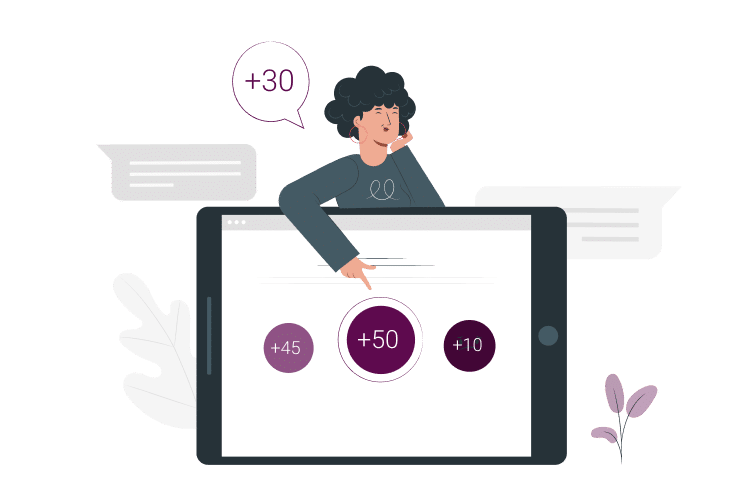Generating leads can be a difficult and time-consuming task for any sales team in any company. Indeed, when the sales team has already identified its leads, they face a new challenge: how to prioritize them? Generally, they trust their instinct and experience to prioritize prospects. As one can imagine, this method is not very precise, can be a source of mistakes and is not scalable.
To avoid this inaccuracy and these lead qualification mistakes, it can be interesting to use an impartial method: lead scoring and its good practices.
Lead scoring allows you to establish a real process around the qualification of your leads by establishing a score for each prospect and associated action. It allows you to identify your prospects in the best possible way by avoiding any sort of bias on the part of sales representatives, which makes it possible to accelerate sales and therefore revenues.
Why set up a scoring strategy in your sales organization?
What is lead scoring?
Lead scoring essentially consists in classifying incoming leads to allow you to identify their chance to become customers. It is therefore a matter of assigning a score to each prospect based on various factors. Once the score has been assigned, it is easy to rank them and prioritize those with the best chance of conversion. This allows your sales and marketing teams to better target the database.

A number of factors can determine these scores.
First, you need to study the prospect’s demographic and declarative characteristics, such as location, company industry, company revenue, and job title – which are useful in determining how close they are to your ideal customer. By optimizing and enriching your data, you will get the most accurate and detailed picture of your prospect as possible. You will reduce your margin of error, so you can focus your efforts on the prospects that are worthwhile.
|
Allocation |
Value |
Score |
|
Critical (10 – 15 points) |
||
|
Position |
VP, Sales |
+12 |
|
Company Industry |
Technology |
+10 |
|
Top issue |
Lead generation |
+15 |
|
Number of employees |
200-1000 |
+13 |
|
Important (5 – 10 points) |
||
|
Location |
US |
+9 |
|
Number of employees |
50-199 |
+8 |
|
Position |
Manager |
+5 |
|
Schedule |
6 months |
+5 |
|
Not negligible (0 – 5 points) |
||
|
Location |
Europe but English speaking |
+4 |
|
Schedule |
12 months |
+2 |
|
Number of employees |
10-49 |
+1 |
|
Negative |
||
|
Position |
Student |
-15 |
|
Company |
No information |
-15 |
|
Location |
Asia |
-10 |
|
Number of employees |
1 or less |
-13 |
(Source: Hubspot)
In addition, to establish a lead scoring strategy, you should also look at the implicit characteristics of the prospect (i.e., their interest in your product). Your prospect’s behavior, such as visiting pricing pages, opening emails, engaging with specific content are all indications of buying behavior and you may vary the lead score accordingly. This is all data you can collect with your marketing automation tool.
|
Assignment |
Score |
|
Critical (10-15 points) |
|
|
Free trial download |
+15 |
|
Visit and click on the price page |
+14 |
|
Request a quote |
+11 |
|
View a demo |
+10 |
|
Important (5 – 9 points) |
|
|
Access to MOFU (middle of the funnel) offer |
+9 |
|
Search for “Hubspot” |
+8 |
|
More than 3 visits on the “Product” page |
+5 |
|
Important activity on the website |
+5 |
|
Not negligible (1 – 4 points) |
|
|
Webinar view |
+4 |
|
Negative |
|
|
Attended an event for more than 30 days |
-5 |
|
Attended an event more than 60 days ago |
-15 |
|
Visit of the “Career” page |
-10 |
|
Unsubscribed from the newsletter |
-5 |
(Source: Hubspot)
What are its benefits?
Lead scoring allows sales representatives to have an overview of their prospect list, with many data points that would be tedious, if not impossible, to discover manually. In fact, lead scoring allows you to automate the qualification of the leads you generate, particularly through your natural referencing efforts.
Thanks to lead scoring, all prospect behaviors are tracked and updated in real time, which allows you to instantly identify which leads to focus on and which ones to leave aside.
Within the framework of the implementation of such a strategy, being visible on social networks is also very important because each behavior of the prospect, whether it is opening an email, making an appointment on the website, consulting the price page and even a reaction to one of your posts on LinkedIn or Twitter, is directly registered in the database and makes the score evolve.
In addition, this prioritization of leads increases the productivity of your teams. If your teams are aware that the leads are well qualified and if they have the right information about their prospects, then they will be more determined and motivated to convert them at all costs.
Furthermore, lead scoring has a significant impact on sales. In fact, 68% of marketers cite lead scoring as one of the most important factors in increasing sales.
Lead scoring also simplifies the sales forecasting process by providing a clear picture of the sales pipeline. This makes it easier for you to make financial and strategic forecasts.
Another benefit of lead scoring is the reduction of your sales cycle time. By giving sales reps key information, they can tailor their sales presentations for maximum impact and avoid wasting time on areas the prospect is not interested in.
Finally, the marketing team will also benefit from lead scoring. By knowing the exact buying factors of your best prospects (and customers), they will be able to adapt their campaigns to make them more effective.
Despite the obvious benefits of lead scoring, customer relationship managers tend not to rely on it for a few reasons.
In fact, lead scoring requires a strong cooperation between your sales and marketing teams so that the sharing of information is optimal, and the lead scoring is best adapted. However, this is often difficult to achieve and there is often a misalignment between those teams. If your marketing team creates lead scoring alone and uses arbitrary data points, sales may be skeptical.
Sometimes, it can be a lack of transparency on the part of the marketing team that’s causing the lack of buy-in from sales. One of the reasons for misalignment between marketing and sales is the two different paradigms of what constitutes a scored lead, that of marketing and that of sales. So each one needs to have its own scoring process.
Lead scoring is only effective if your lead scoring parameters reflect the profile of your ideal customer. Unfortunately for you, it is difficult to define what makes a customer ideal. What factors really determine the probability of a prospect becoming a customer? If the factors can be easily identified, it is necessary to be able to give them a score that does not bias the overall score too much.
Your lead scoring must include additional qualifiers beyond the marketing data. And these should reflect the reality of what your customer relationship manager experiences on a daily basis. For example, your sales score might include the following:
- Budget: Can the prospect afford to buy your product?
- Authority: Is your contact the final decision maker?
- Need: Does your product address a real pain point for the prospect?
- Timing: Is your prospect in a position to buy now?
- You then assign values to each of the elements.
Good lead scoring practices
In order to have an efficient lead scoring that does not mislead you, it is necessary to respect some good practices. Here are a few of them:
- Create separate lead scoring templates for different products and services. For example, if you have an offer for businesses and another for small businesses, you may have different criteria for each.
- Determine your lead scoring threshold. This is the decisive criterion that moves your prospect into qualified sales territory. Categorize high-value actions. What actions would a motivated buyer take? Visit the “Contact Us” page on your site? Scroll down the pricing page?
- Integrate lead scoring into your campaign workflows. What happens at each stage of scoring? An email gets sent, a phone call is made, a direct mail is sent? Your marketing and sales teams need to collaborate in these workflows.
- Use negative scoring to filter out bad leads. Not all prospects are created equally. Over time, the lead’s score should degrade if there has been no positive action. Also determine which web pages are intended for non-buyers (like your Careers page, for example).






